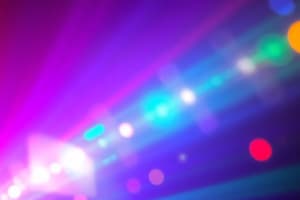Podcast
Questions and Answers
Which of the following describes luminescence?
Which of the following describes luminescence?
- Light emitted during electric discharge
- Light produced by living organisms
- Light produced without significant heat (correct)
- Light emitted from heated objects
Phosphorescence involves immediate emission of light without any delay.
Phosphorescence involves immediate emission of light without any delay.
False (B)
What is an example of bioluminescence?
What is an example of bioluminescence?
Fireflies
Neon lights produce light through __________.
Neon lights produce light through __________.
Match the following light sources with their descriptions:
Match the following light sources with their descriptions:
Flashcards
Bioluminescence
Bioluminescence
Light produced by a chemical reaction in a living organism, without significant heat.
Phosphorescence
Phosphorescence
Light emitted by a substance after absorbing high-energy UV light, continuing to glow even after the source is removed.
Fluorescence
Fluorescence
Light produced when a substance absorbs high-energy UV light and re-emits it as visible light.
Incandescence
Incandescence
Signup and view all the flashcards
Electric Discharge
Electric Discharge
Signup and view all the flashcards
Study Notes
Light Sources
-
Sunlight/Nuclear Fusion: Light from nuclear fusion in the Sun, where hydrogen joins to form helium, releasing energy
-
Examples: Sunlight, solar radiation
-
Incandescence: Light produced by heating an object to a high temperature, making it glow
-
Examples: Light bulb filament, molten metal
-
Electric Discharge: Light created when an electrical current passes through a gas, exciting its atoms to emit light
-
Examples: Neon lights, lightning
-
Luminescence: Light generated without significant heating, often by chemical or physical processes
-
Examples: Glow sticks, LED lights
-
Fluorescence: Light from a substance absorbing high-energy UV light and emitting visible light
-
Examples: Fluorescent lamps, highlighters
-
Phosphorescence: Similar to fluorescence, but light emission continues after the energy source is removed
-
Examples: Glow-in-the-dark toys, watch dials
-
Chemiluminescence: Light from a chemical reaction without a temperature increase
-
Examples: Glow sticks, some chemical tests
-
Bioluminescence: Light produced by living organisms through chemical reactions within their bodies
-
Examples: Fireflies, deep-sea organisms
Studying That Suits You
Use AI to generate personalized quizzes and flashcards to suit your learning preferences.



